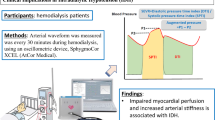Abstract
An elevated pulse pressure leads to an increased pulsatile cardiac load, and results from arterial stiffening. The aim of our study was to test whether a reduction in volume overload by ultrafiltration (UF) during haemodialysis (HD) leads to an improvement of aortic compliance. In 18 patients, aortic compliance was estimated noninvasively before and after HD with UF using a pulse pressure method based on the Windkessel model. This technique has not been applied before in a dialysis population, and combines carotid pulse contour analysis by applanation tonometry with aortic outflow measurements by Doppler echocardiography. The median UF volume was 2450 ml (range 1000–4000 ml). The aortic outflow volume after HD (39 ml; 32–53 ml) was lower (P=0.01) than before (46 ml; 29–60 ml). Carotid pulse pressure after HD (42 mmHg; 25–85 mmHg) was lower (P=0.01) than before (46 mmHg; 35–93 mmHg). Carotid augmentation index after HD (22%; 3–30%) was lower (P=0.001) than before (31%; 7–53%). Carotid–femoral pulse wave velocity was not different after HD (8.7 m/s; 5.6–28.9 m/s vs 7.7 m/s; 4.7–36.8 m/s). Aortic compliance after HD (1.10 ml/mmHg; 0.60–2.43 ml/mmHg) was higher (P=0.02) than before (1.05 ml/mmHg; 0.45–1.69 ml/mmHg). The increase in aortic stiffness in HD patients is partly caused by a reversible reduction of aortic compliance due to volume expansion. Volume withdrawal by HD moves the arterial wall characteristics back to a more favourable position on the nonlinear pressure–volume curve, reflected in a concomitant decrease in arterial pressure and improved aortic compliance.
This is a preview of subscription content, access via your institution
Access options
Subscribe to this journal
Receive 12 digital issues and online access to articles
$119.00 per year
only $9.92 per issue
Buy this article
- Purchase on Springer Link
- Instant access to full article PDF
Prices may be subject to local taxes which are calculated during checkout

Similar content being viewed by others
References
London G et al. Cardiac hypertrophy and arterial alterations in end-stage renal disease: hemodynamic factors. Kidney Int 1993; 43: S42–S49.
Benetos A et al. Pulse pressure. A predictor of long-term cardiovascular mortality in a French male population. Hypertension 1997; 30: 1410–1415.
London GM et al. Arterial structure and function in end-stage renal disease. Nephrol Dial Transplant 2002; 17: 1713–1724.
London GM, Cohn JN . Prognostic application of arterial stiffness: task forces. Am J Hypertens 2002; 15: 754–758.
Guerin AP, London GM, Marchais SJ, Metivier F . Arterial stiffening and vascular calcifications in end-stage renal disease. Nephrol Dial Transplant 2000; 15: 1014–1021.
London GM . Left ventricular alterations and end-stage renal disease. Nephrol Dial Transplant 2002; 17 (Suppl 1): 29–36.
Tycho Vuurmans JL et al. Contribution of volume overload and angiotensin II to the increased pulse wave velocity of hemodialysis patients. J Am Soc Nephrol 2002; 13: 177–183.
Shichiri M et al. Plasma endothelin levels in hypertension and chronic renal failure. Hypertension 1990; 15: 493–496.
Vallance P et al. Accumulation of an endogenous inhibitor of nitric oxide synthesis in chronic renal failure. Lancet 1992; 339: 572–575.
Safar ME et al. Central pulse pressure and mortality in end-stage renal disease. Hypertension 2002; 39: 735–738.
Blacher J et al. Arterial calcifications, arterial stiffness, and cardiovascular risk in end-stage renal disease. Hypertension 2001; 38: 938–942.
Blacher J et al. Impact of aortic stiffness on survival in end-stage renal disease. Circulation 1999; 99: 2434–2439.
Blacher J et al. Aortic pulse wave velocity index and mortality in end-stage renal disease. Kidney Int 2003; 63: 1852–1860.
London GM et al. Arterial wave reflections and survival in end-stage renal failure. Hypertension 2001; 38: 434–438.
Carlier S et al. Non-invasive characterization of total arterial compliance by simultaneous acquisition of pressure and flow: advantages of the pulse pressure method. Comput Cardiol 1998; 25: 665–668.
Cheriex EC et al. Echography of the inferior vena cava is a simple and reliable tool for estimation of ‘dryweight’ in haemodialysis patients. Nephrol Dial Transplant 1989; 4: 563–568.
Leunissen K et al. New techniques to determine fluid status in hemodialyzed patients. Kidney Int 1993; 41: S50–S56.
Chen CH et al. Validation of carotid artery tonometry as a means of estimating augmentation index of ascending aortic pressure. Hypertension 1996; 27: 168–175.
Liebson PR et al. Echocardiographic correlates of left ventricular structure of 844 mildly hypertensive men and women in the treatment of mild hypertension study (TOMHS). Circulation 1993; 87: 476–486.
Covic A et al. Analysis of the effect of hemodialysis on peripheral and central arterial pressure waveforms. Kidney Int 2000; 57: 2634–2643.
Kosch M et al. Acute effects of hemodialysis on endothelial function and large artery elasticity. Nephrol Dial Transplant 2001; 16: 1663–1668.
McVeigh GE . Pulse waveform analysis and arterial wall properties. Hypertension 2003; 41: 1010–1011.
O'Rourke MF, Mancia G . Arterial stiffness. J Hypertens 1999; 17: 1–4.
Safar ME, Levy BI, Struijker-Boudier H . Currents perspectives on arterial stiffness and pulse pressure in hypertension and cardiovascular disease. Circulation 2003; 107: 2864–2869.
Mitchell GF et al. Determinants of elevated pulse pressure in middle-ages and older subjects with uncomplicated systolic hypertension. Circulation 2003; 108: 1592–1598.
Hughes SMT, Dixon LJ, McVeigh GE . Arterial stiffness and pulse wave velocity: problems with terminology. Circulation 2004; 109: e3.
Barenbrock M et al. Studies of vessel wall properties in hemodialysis patients. Kidney Int 1994; 45: 1397–1400.
Lin YP et al. The extracellular fluid-to-intracellular fluid volume ratio is associated with large-artery structure and function in hemodialysis patients. Am J Kidney Dis 2003; 42: 990–999.
Author information
Authors and Affiliations
Corresponding author
Rights and permissions
About this article
Cite this article
Ie, E., De Backer, T., Carlier, S. et al. Ultrafiltration improves aortic compliance in haemodialysis patients. J Hum Hypertens 19, 439–444 (2005). https://doi.org/10.1038/sj.jhh.1001813
Received:
Revised:
Accepted:
Published:
Issue Date:
DOI: https://doi.org/10.1038/sj.jhh.1001813
Keywords
This article is cited by
-
Acute vs chronic volume overload on arterial stiffness in haemodialysis patients
Journal of Human Hypertension (2005)



